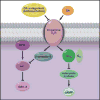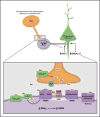Signaling pathways in schizophrenia: emerging targets and therapeutic strategies
- PMID: 20579747
- PMCID: PMC3635536
- DOI: 10.1016/j.tips.2010.05.004
Signaling pathways in schizophrenia: emerging targets and therapeutic strategies
Abstract
Dopamine D(2) receptor antagonism is a unifying property of all antipsychotic drugs in use for schizophrenia. While often effective at ameliorating psychosis, these drugs are largely ineffective at treating negative and cognitive symptoms. Increasing attention is being focused on the complex genetics of the illness and the signaling pathways implicated in its pathophysiology. We review targeted approaches for pharmacotherapy involving the glutamatergic, GABAergic and cholinergic pathways. We also describe several of the major genetic findings that identify signaling pathways representing potential targets for novel pharmacological intervention. These include genes in the 22q11 locus, DISC1, Neuregulin 1/ErbB4, and components of the Akt/GSK-3 pathway.
2010 Elsevier Ltd. All rights reserved.
Figures






References
-
- Lewis DA, Lieberman JA. Catching up on schizophrenia: natural history and neurobiology. Neuron. 2000;28:325–334. - PubMed
-
- Carlsson A. The current status of the dopamine hypothesis of schizophrenia. Neuropsychopharmacology. 1988;1:179–186. - PubMed
-
- Steinpreis RE. The behavioral and neurochemical effects of phencyclidine in humans and animals: some implications for modeling psychosis. Behav Brain Res. 1996;74:45–55. - PubMed
-
- Buchanan RW, et al. The Cognitive and Negative Symptoms in Schizophrenia Trial (CONSIST): the efficacy of glutamatergic agents for negative symptoms and cognitive impairments. Am J Psychiatry. 2007;164:1593–1602. - PubMed
Publication types
MeSH terms
Substances
Grants and funding
LinkOut - more resources
Full Text Sources
Medical

